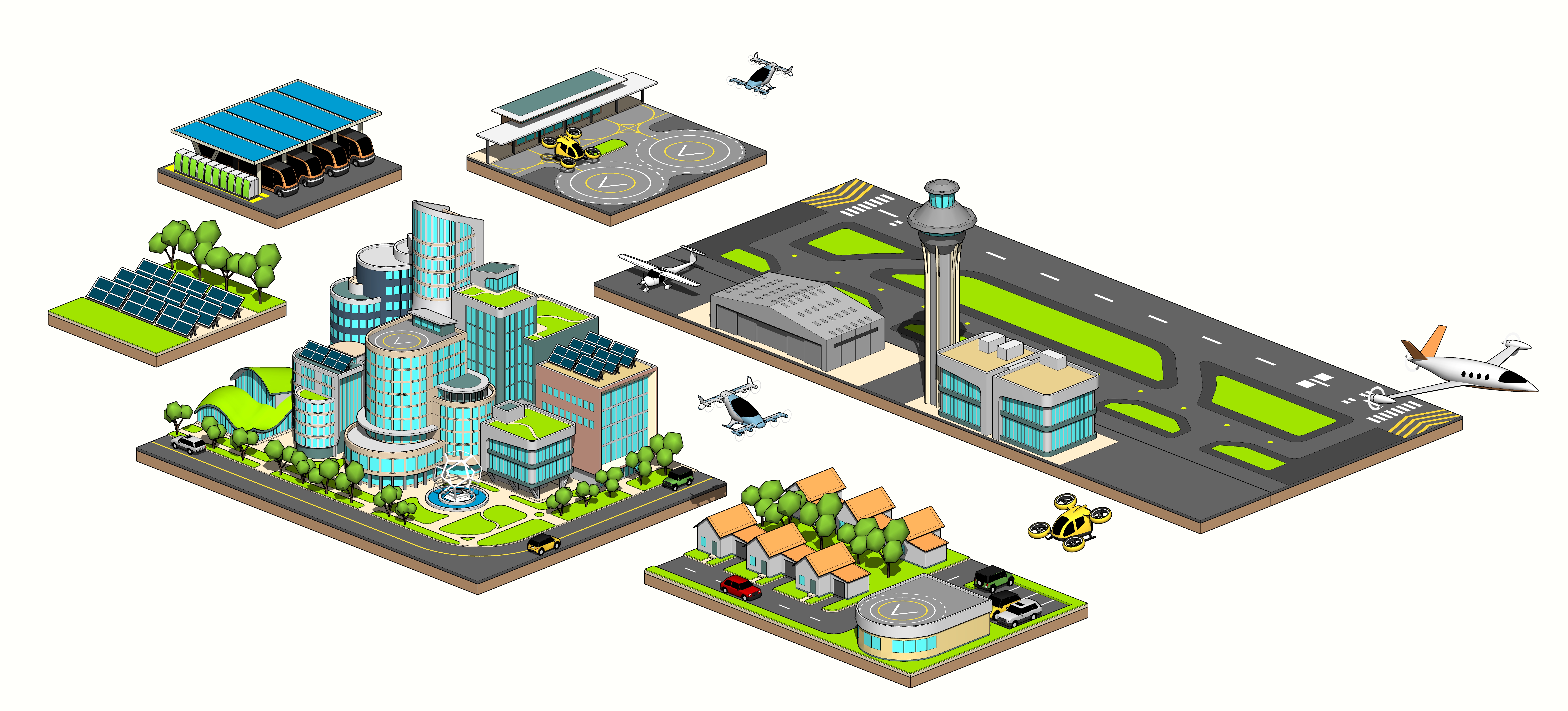- October 28, 2024
- Perspectives
Navigating the Future of Transportation: Strategies for Implementing Advanced Air Mobility


John Coliton, AICP
Aviation Planner

Erin Sheelen, AICP
Transportation Planner
Advanced Air Mobility (AAM) has generated a lot of buzz in recent years as the prospect of using drones and electric vertical takeoff and landing (eVTOL) aircraft for a multitude of use cases inches closer to a reality.
Now, as AAM begins to transition from research and development to adoption and implementation, we are starting to witness the realization of its highly anticipated benefits—from uncrewed aircraft systems (UAS) (i.e., drones) performing commercial last-mile package delivery in several markets to significant milestones in the certification of eVTOL aircraft. Excitement continues to build for the possibility of AAM transforming transportation, tourism, healthcare, and more.
However, given the emerging nature of the industry, it is imperative that practicality and adaptability are cornerstones of any investment decision. For those looking to leverage AAM within their community, at an airport, or as part of a development project, there are several key factors to consider.
AAM Planning and Infrastructure Needs
There is no one-size-fits-all solution to AAM implementation. Use cases (e.g., passenger transportation, package delivery, or agriculture applications), operating environments, regulatory requirements, and potential benefits all differ from community to community. Before diving headfirst into detailed AAM planning, it is crucial to first define the “why” behind your potential investment decisions. Some questions to ask are:
- What are the ultimate objectives of incorporating an eVTOL vertiport or UAS infrastructure at my facility?
- What AAM use case(s) best align with the unique needs of my airport, community, or business?
- What infrastructure improvements are needed to support AAM?
- How will this AAM project be funded (e.g., privately or publicly)?
Will the investments be supported by primary stakeholders, decision makers, and the public?
- Is there a solid business case for AAM at my facility? If so, what is the expected return on investment?
In addition to these foundational questions, developing a comprehensive stakeholder engagement strategy is also critical. Depending on your project’s location, use case(s), and regulatory environment, AAM stakeholders may include:
- Community representatives and advocacy groups
- Local, regional, and state government agencies and organizations
- Utility providers
- Airport users, tenants, and air traffic control (for on-airport facilities)
- Federal Aviation Administration (FAA) Regional Airports Division and District Offices (ADOs)
- Emergency services providers
- Original Equipment Manufacturers (OEMs)
Setting clear goals and developing an implementation strategy in partnership with stakeholders will guide decision making, promote a pragmatic approach to infrastructure planning, and ensure that AAM investments are consistent with community needs and align with your ultimate vision.
Developing Your Strategy for AAM Implementation
Each AAM use case presents unique advantages, challenges, and steps for implementation. For example, if your goal is to enable eVTOL cargo transportation, payload capacity and vertiport location considerations will differ from those for passenger transportation, aeromedical services, and air tours. Additionally, eVTOL aircraft needs will vary from UAS infrastructure—from energy capacity requirements and beyond visual line of sight (BVLOS) capabilities to environmental clearance, airspace integration, and regulatory approval. No matter the use case, there are several key planning and infrastructure elements to consider as practical starting points to any AAM development.
Planning and Environmental Reviews
Start by engaging your FAA ADO, department of transportation (DOT), local planning agencies, utility providers, private industry, and other key stakeholders. Additionally, consult local, state, and federal environmental processes to determine the required steps, approvals, and timelines associated with regulatory review. For airports seeking to develop AAM infrastructure, especially those eligible to receive federal grants, updating your Airport Layout Plan (ALP) will foster a comprehensive review of facility needs, development alternatives, potential challenges, and a preferred concept for design and construction.
Charging and Electric Infrastructure
One of the primary needs for AAM is robust electric infrastructure to support high-capacity and rapid charging of UAS and/or eVTOL aircraft. Considerations include existing electric capacity, access to three-phase power, and available space for charging facilities. Coordination with utility providers is crucial to ensure reliable power supply to support increased loads, identify future electric capacity from the grid, and if needed, explore future onsite power generation opportunities like microgrid systems.
Airspace Integration
Whether located on or off an airport, effective airspace planning is crucial to integrate AAM operations safely with existing air traffic, protect people and property on the ground, and promote a safe and efficient operating environment. While the FAA traditionally handles airspace coordination, local stakeholders must take active roles in airspace planning—including FAA coordination and community engagement—for AAM operations within their community.
Fire Suppression and Emergency Response
Safety is paramount in all aviation operations, especially when additional hazards are introduced through lithium-ion batteries and aircraft operations in non-traditional aviation environments. To mitigate the risks of thermal runway and chemical releases associated with battery fires, vertiports and UAS facilities should have proper fire suppression systems in place, including fire extinguishers, sprinkler systems, and emergency response plans. Ongoing coordination with local emergency services and regular training for responders are vital to ensure a rapid response in case of an incident.
Zoning and Land Use
For AAM implementation, zoning and land use compatibility are critical. To incorporate AAM into your community, it is essential to establish a zoning framework to support AAM development and operations. This requires early engagement and close collaboration with local and regional governments to establish a regulatory environment that facilitates the adoption of AAM.
Depending on your location, selected use cases, and objectives, additional AAM infrastructure considerations may include:
- Lighting and navigational aids (NAVAIDs)
- Ground service equipment (GSE)
- Passenger waiting areas
- Cargo handling facilities
- Aircraft storage hangars and maintenance facilities
- First-/last-mile transportation
- Structure load requirements (for elevated AAM facilities)
Flexibility and Adaptation

Since the AAM industry is in its infancy, it’s important to remain flexible and adaptable. AAM planning and design should allow for modifications and re-tooling to support new technologies, evolving regulations, facility expansion to meet future demand, and interoperability among different aircraft types. When making investment decisions, prioritize key items that will provide long-term benefits. For example, investing in electric capacity, airspace obstruction clearance, and communications infrastructure can yield immediate benefits for your development and community while also laying the foundation for future AAM operations.
AAM has the potential to revolutionize and enhance connectivity and services across many industries. As UAS and eVTOL aircraft transition into the preliminary stages of operations, we can begin to understand the “real-life” infrastructure needs, challenges, and overall implications of operations. To successfully navigate this environment, we are equipped to assist you throughout the AAM project life cycle, including planning, environmental clearances, stakeholder coordination, grant and funding assistance, facility design, and construction phase services. We will partner with you to develop a realistic AAM strategy rooted in flexibility, adaptation, and stakeholder engagement to collectively achieve your mobility goals.
About the Experts

John Coliton, AICP
John has contributed to a diverse portfolio of aviation planning projects in his 10 years at Kimley-Horn, including AAM and legacy aviation studies for more than 40 airports across the U.S. A leader of Kimley-Horn’s emerging aviation technologies practice, John has established himself as an industry subject matter expert in AAM, airport electrification, and airspace integration through his work for commercial service and general aviation airports, state DOTs, and private industry as well as his active involvement in AAAE, ACC, and TRB. A proud member of AICP, John combines planning principles with his passion for aviation to provide practical and sustainable solutions to airports, communities, and their stakeholders.

Erin Sheelen, AICP
Erin has almost two decades of experience in the aviation industry serving clients across the nation, ranging from small general aviation airports to large- and medium-hub airports. She is involved in the planning and application of emerging technologies such as AAM, unmanned aircraft systems, and modeling. Erin has managed, researched, evaluated, and written state and regional system plans, commercial and general aviation master plans, sustainability evaluations, land use compatibility plans, FAA aerial surveys, environmental studies, and grant projects.
